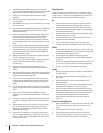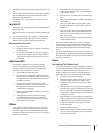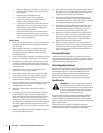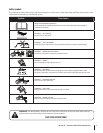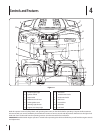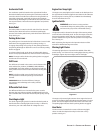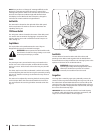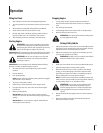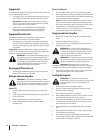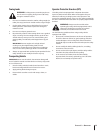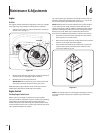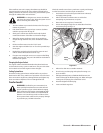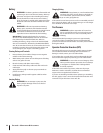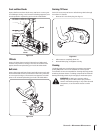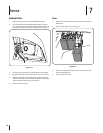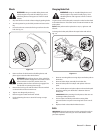
12 se c t i O n 5— Op e r a t i O n
Engaging 4x4
The 4x4 switch is located on the right side of the dash panel. See
the Controls & Features section.
To engage, stop or slow vehicle speed and push up on the 1.
switch. All four wheels will now continue to have power.
IMPORTANT: Engage the 4x4 feature as the first option
when stuck in mud or similar situation where two wheel
drive is ineffective at moving vehicle.
If still unable to move vehicle with the 4x4 engaged, 2.
disengage 4x4 by pushing down on the switch and
engaging the differential lock as described below.
Engaging Differential Lock
The differential lock lever is located in the center console
between the seats. See Know Your Utility Vehicle.
To engage, stop vehicle, place into Neutral, and pull the 1.
lever rearward. The differential will then lock and remain
so until it is disengaged, giving continuous power to both
rear wheels.
IMPORTANT: Engage the differential as the last option when
stuck in mud or similar situation or when the left and right side
wheels are turning at slightly different speeds.
WARNING: To avoid transmission damage, injury,
or turf damage, go slow when operating vehicle
with differential lock engaged as steering response
is noticeably reduced. Also, do not drive the unit
with the differential lock engaged on concrete,
asphalt or any high traction surfaces.
Disengaging Differential Lock
To disengage the differential lock, stop the unit, place in 1.
Neutral, and push the lever forward.
Raising & Lowering Cargo Box
WARNING: To prevent the possibility of bodily
injury from unintentional lowering of the cargo box,
be sure vehicle is on a level and stable surface and
parking brake is locked before raising cargo box.
Manual Lift
Park the vehicle safely on level ground and set parking 1.
brake.
Empty cargo by hand and unlatch cargo box by pulling up 2.
on the cargo latch.
While holding the latch up, lift the cargo box.3.
Lower and allow bed to re-latch cargo box before 4.
operating unit.
Electric Lift (Optional)
Park the vehicle safely and turn key to the RUN position.1.
Raise cargo box by pressing and holding top of electric lift 2.
switch. Release switch when box is at desired dump height
or when maximum height is reached.
NOTE: A ratcheting noise will indicate cargo box is at full
extension. The same noise will also be heard when cargo
box is at the full down position. If lift capacity of the power
lift is exceeded, a ratcheting will also be heard.
To lower cargo box, push on bottom of electric lift switch. 3.
Turn ignition switch to the STOP position.
Dumping Load From Cargo Box
Back up the vehicle to the dump site and apply parking 1.
brake.
Unlatch the tailgate from cargo box.2.
If using an electric lift, raise cargo box to dump load and 3.
lower box when empty.
WARNING: The center of gravity changes as a
loaded cargo box is raised. Do not allow rear wheel
to hang over the edge of a loading dock or ravine.
The cargo box weight may shift over center and
vehicle could tip over backwards.
WARNING: A loaded cargo box can be very heavy.
Do not attempt to dump a loaded cargo box unless
vehicle is equipped with an electric lift option.
IMPORTANT: If dumping by electric lift, stop
immediately if actuator clutch slippage occurs. Lower cargo box
completely and remove excess load by hand before dumping.
Reconnect the tailgate to the cargo box. Do not drive the 4.
vehicle with cargo box in the raised position.
Loading the Cargo Box
WARNING: The utility vehicle may become
unstable if the cargo box is loaded incorrectly. Avoid
loose and shifting loads or uneven loading of
material.
Verify cargo box is latched before loading.1.
Securely anchor all loads in cargo box and do not load 2.
beyond maximum capacity.
The maximum box capacity is 1,000 lbs..3.
When loading objects into vehicle, be sure load is securely 4.
anchored and evenly distributed in cargo box.
Do not load above height of cargo box front panel. Load 5.
could shift forward striking driver or passenger or cause
driver to loose control of vehicle.
Avoid loads which exceed physical dimensions of cargo 6.
box.
Avoid concentrated loads at rear or side of cargo box. Be 7.
sure load is distributed evenly.
Reduce load and ground speed when operating over 8.
rough or hilly terrain. DO NOT overload vehicle. Limit loads
to those that can be safely controlled.



